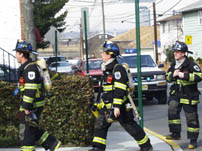“Even on what people might call routine calls, firefighters are at risk,” says Councilman John Reilly, steering his car through traffic along Paterson Plank Road from the northend in response to report of a house fire. The blue firefighter light flashes from dozens of other vehicles in Secaucus as other volunteers scurry out from their usual Sunday morning activities to answer the call. Reilly, one of the 60 volunteers who make up the volunteer fire department, had been on his way to the northend on another matter when the call came in, forcing him to turn around and follow a route that – coincidentally – was the same route fellow firefighter Joe Tagliani followed last June when a sudden heart attack ended his life. The 34-year-old Tagliani had been driving the rig out of the northend fire house when he complained of chest pains and had the good sense to pull the vehicle to the side of the road, before collapsing. Although trained in CPR and First Responder techniques, his fellow firefighters, who immediately began cardiopulmonary resuscitation until an ambulance arrived, could not save his life. Even Meadowlands Hospital, with all its resources, could only sustain his life for 13 days. “I’m not saying anything bad about the Meadowlands Medical Center,” Reilly said. “They did a fantastic job. But Joe’s death and the vulnerability of our firefighters made me think about what we might be able to do to help protect our own people a little better, giving them something more to make sure they can be taken care of in an emergency.” Tagliani was not the first Secaucus firefighter to die in the line of duty. The names of the fire department’s deceased veterans are engraved in stone in front of Town Hall: John Keilp, March 12, 1930; George Bellis, March 15, 1935; William Bo Koenemund, Sept. 2, 1985, and Tagliani, June 13, 1999. Many of the elder members of the fire department remember Koenemund’s heroics, a man who in the middle of the great Labor Day fire in Passaic also suffered a heart attack. “It’s a scary thing,” Reilly says as he turns his car onto the first street ramp connecting Paterson Plank Road with Flanagan Way. Reilly knows how risky a job it is firsthand. In 1998, he had his own brush with death when he responded to a fire at Eighth Street and Centre Avenue, only to find someone trapped inside the blaze. Reilly, a member of the department for 25 years, carried the 81-year-old man to safety, fell, and collapsed after his oxygen pack ran out of air while he was in the building. “I got the idea that maybe the department needed [its own doctor] while I was visiting my doctor,” Reilly says as he turns his car onto Flanagan Way, his radio rasping with the response of other fire vehicles, all of them converging on the corner of Hudson Avenue and Front Street. The voices of other firefighters already on the scene give the details: saying the fire started in the kitchen, apparently due to unattended cooking. Reilly steps a little harder on the gas; the car moves a little more quickly towards the scene. He talks as he steers the car, saying how he pondered the subject in front of his cardiologist, and the doctor volunteered. “Dr. Rick Pumill is well-known as a cardiologist,” Reilly says. “He has offices in various parts of Hudson County and he has a good reputation. The fact that he wanted to do it delighted me.” Pumill, who will be sworn in next week as the police and fire doctor, will help make sure that an injured firefighter gets the proper care, guiding the man through the medical system. He will do this on a volunteer basis. “He’ll be on the scene or at the hospital, whenever someone gets hurt,” Reilly says. “He won’t get paid unless the firefighter opts to use him as a primary physician. We just want him to make sure that all the proper medical steps are being taken for our firefighters, our police offices and the members of the Office of Emergency Management.” Reilly calls it an “extra level of protection,” noting that police officers and firefighters already get physicals through the health care program. “Yet, if someone has something they are worried about, they can come to Dr. Pumill for advice,” Reilly says, steering the car finally to the scene of the fire, where four engines crisscross the streets and firefighters rush in and out of the house carrying fans and extinguishers. The blaze is out, but the smoke billows out the front door, carrying to the street the smell of burnt pancakes. Unlike the blaze a week earlier a few doors down the street, no residents or firefighters are hurt, and no one has to withstand a wall of flames. Several firefighters, however, help calm a shaken woman who stands near the door. “All fires are dangerous, even ones that seem as simple as this,” Reilly says, returning to his car after a few minutes talking with firefighters on the scene. He is in a hurry again, not to report to another fire, but to make his way to the center of town before church lets out. “I want to talk to this woman’s daughter before one of the neighbors does,” he says and swings the car around. “I don’t want her to hear there’s been a fire in her house where her mother is alone. I want to make sure she knows everything is all right and no one was hurt.” He says small details like these help make Secaucus the town it is, people caring for people, whether it means providing a doctor for firefighters or driving to church to help calm a worried daughter’s nerves. “This is what Secaucus is all about,” he says.
Firefighters and police get a doctor of their own
